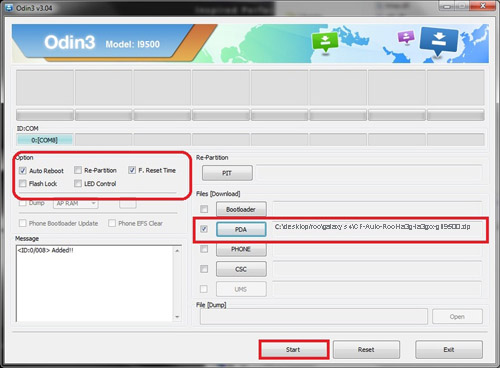

- #How to flash with odin s4 how to
- #How to flash with odin s4 mac os x
- #How to flash with odin s4 install
- #How to flash with odin s4 zip file
- #How to flash with odin s4 Patch
The ID:COM section in Odin will light up once it identifies the connection to your phone.Ĭlick on the AP button in Odin and select the MD5 file you extracted from the firmware package you downloaded. Launch Odin and connect the phone to PC via USB cable. (avoid - That site has malware on it) Extract the contents of this into the same folder in which you placed the firmware from step 2.
#How to flash with odin s4 zip file
Download this one: AT&T Galaxy S4 SGH-I337 UCUFNB1 (Android 4.4.2)Įxtract the contents of this zip file into a temporary folder.ĭownload Odin v.3.10 (or higher) from. You will be shown a screen which will read: "Warning!! A custom OS can cause." Press the "Volume Up" key to continue onto "Download Mode."ĭownload the AT&T Galaxy S4 Stock Firmware - SGH-i337 Get your phone into "Download Mode." This is done by turning the phone off and turning it on by pressing the "Volume Down key, Home button, and the Power button, at the same time. Fortunately, I was able to restore the device using the following method: This resulted in a soft-bricking of the device.
#How to flash with odin s4 install
My original intention was to unlock and install Cyanogenmod 12.1 on a locked AT&T Samsung Galaxy S4 (SGH-I337). I had read to check the cable and switch ports in other situtations, and after seeing the intermittent failures, this seemed to be the trick that allowed me to successfully flash the large system file without error and ultimately get the phone running. It is important to note that the libusbx errors that I was getting was resolved by moving my USB cable to a different port on my MacBook Pro. Absent of any issues, I believe the flashing could be done in one pass, but I haven't confirmed. By flashing the recovery and boot partitions first, I noticed the benefit of bringing online the firmware recovery process, which could open up some additional possible alternatives like ADB sideloading.

By trial and error, I noticed that the errors were more common on the large 4 file and had moved it to the final pass. I happened to experience intermittent USB errors ( libusbx: error bulk transfer failed (dir = In): no connection to an IOService (code = 0xe00002c0)) during several attempts. Heimdall flash -APNHLOS NON-HLOS.bin -ABOOT aboot.mbn -MDM modem.bin -RPM rpm.mbn -SBL1 sbl1.mbn -SBL2 sbl2.mbn -SB元 sbl3.mbn -PERSDATA 4 -TZ tz.mbn -CACHE 4 heimdall flash -RECOVERY recovery.img -HIDDEN 4 -BOOT boot.img Instead of ODIN for steps 5 - 7, I used Heimdall as follows in three passes of flashing and rebooting to Download mode (see step 2 above).
#How to flash with odin s4 how to
I followed the steps below from xda (but using Heimdall instead of ODIN): HOW TO GET TO ANY KITKAT 4.4.2 (NB1, NC1, NI1) OR 4.4.4 (NJ4, NJ5) BASE. I found some good Heimdall basics and insights here at xda and here at kossboss.
#How to flash with odin s4 Patch
I had to get the signed patch that is available in this thread.

I have used Heimdall to flash firmware to my Galaxy S4 before, but I ran into problems more recently getting it installed on El Capitan.
#How to flash with odin s4 mac os x
I encountered this same situation and was able to get back to a base level using Heimdall on Mac OS X El Capitan 10.11.2. However, if I am able to somehow circumvent this step and install a CyanogenMod (nightly build), I would prefer that, instead.) (My first priority is to get the phone back to it's original running condition. I require very specific directions on where to obtain each component, and exactly how to go about restoring this device. However, with so many versions of Odin, as well as the firmware builds available, not to mention the options and toggles available within Odin, I have no way of knowing if I'm doing this correctly. I downloaded Odin and a Samsung S4 firmware image, and attempted to flash it, but received a FAIL error towards the end. I have tried using Kies v.2.6, as well as v.3. On the top left of the screen, the following information is displayed: Please select recovery mode in Kies & try again." This message is prominently displayed underneath a "device to PC connection" graphic.


 0 kommentar(er)
0 kommentar(er)
